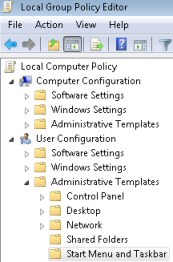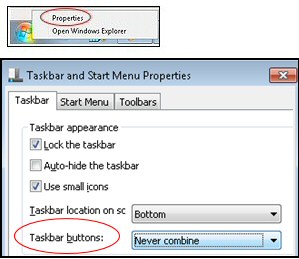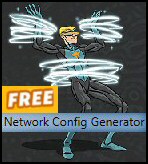Windows 7 Quick Launch
In Vista 7 the Quick Launch area has been absorbed into the taskbar. However, you can either modify the Windows 7 taskbar to look like Vista’s Quick Launch, or you can take steps to actually recreate Quick Launch area as a toolbar.
Microsoft Windows 7 New Taskbar Review
- Windows 7 Quick Launch Strategy
- How to Return to the Vista Quick Launch Technology
- Gpedit.msc Configures Quick Launch in Windows 7
- Force Classic Start Menu
- Windows 7 Taskbar – New Philosophy for Programs
- Windows 7 Notification Area
♦
Windows 7 Quick Launch Strategy
One of the first things you notice when you upgrade from Vista to Windows 7 is the new Taskbar. While I like the philosophy behind the Windows 7 version of taskbar, I am assuming that you don’t like the new look and feel, furthermore, you want to return to the Vista state of affairs. Now it is possible to create an actual Quick Launch toolbar, and you will be pleasantly surprised that if you have upgraded from Vista, then all your old shortcuts will reappear there. However, I would recommend that you ignore the Quick Launch toolbar, and instead, modify the properties of Windows 7’s native taskbar.
How to Return to the Vista Quick Launch Technology
These steps explain how to get back to the old Quick Launch, the concept is to create a toolbar in Windows 7, which points to a specific folder, thus:
- Copy this string into memory:
%userprofile%\AppData\Roaming\Microsoft\Internet Explorer\Quick Launch - right-click on the Taskbar, choose Toolbars and then New Toolbar.
- Now paste (the above string) into the Folder dialog box
- Click SAVE

- Now you should see the chevrons of the Quick Launch bar at the right of the Taskbar.
- Finally, right-click on the Taskbar near the Start orb, select Properties, and turn off ‘Lock the taskbar’.

Footnote: You can also create a toolbar for the Programs folder. Use the above method and just substitute this string: C:\ProgramData\Microsoft\Windows\Start Menu\Programs
Windows 7 Quick Launch in Action
Once your old Quick Launch toolbar appears click on the chevron arrows to see your old shortcuts (see screenshot to the right).
Alternatively, right-click Quick Launch itself, select ‘Open Folder’ and then drag new shortcuts into the underlying Quick Launch Folder. I say again, choose ‘Open Folder’ and not properties.
I have to admit that while the new taskbar is great for programs, there are shortcuts to non-exe files that you cannot drag into the Windows 7 Taskbar, for these shortcuts the Quick Launch is a good solution.
Recommended: Solarwinds’ Permissions Analyzer – Free Active Directory Tool
I like the Permissions Monitor because it enables me to see WHO has permissions to do WHAT at a glance. When you launch this tool it analyzes a users effective NTFS permissions for a specific file or folder, and takes into account network share access, then displays the results in a nifty desktop dashboard!
Think of all the frustration that this free SolarWinds utility saves when you are troubleshooting authorization problems for user’s access to a resource. Give this permissions monitor a try – it’s free!
Download SolarWinds’ Free Permissions Analyser – Active Directory Tool
Gpedit.msc Configures Quick Launch in Windows 7
There is also a parallel method to display the Quick Launch area in Windows 7 by using Gpedit.msc. Incidentally, if you visit this area of Local Computer Polies then you are almost certain to find other settings that you will enjoy adjusting.
- Click on the Start orb, and in the search dialog box type: gpedit.msc
Note: Most people forget to type the .msc file extension, consequently nothing happens. - Navigate inside the Local Computer Policy, and drill-down to the User Configuration.
- Expand the Administrative Templates.
- Click on: ‘Start Menu and Taskbar’.
- Select the policy: Show Quick Launch on Taskbar.
- Double click, and set the radio button at ‘Enabled’.
- To see the effect of changes to User Configuration settings all you usually need to do is a logoff / logon routine. However, this did not work for me so I rebooted.
- Unfortunately, Quick Launch still did not appear. I wonder if it was because I had been messing about with the toolbar method above?
Tip for lovers of keyboard shortcuts. Windows Key + 1 (or 2, 3,4) launches one of the programs in the taskbar. Actually, this also works in Vista and maybe even earlier systems.
Modify the Windows 7 Taskbar to Emulate Vista’s Quick Launch
There are even more options for the Windows 7 taskbar than there were in Vista, begin your quest to emulate the Quick Launch by right-clicking near the Start orb and selecting Properties. Incidentally, I could not get ‘Properties’ to appear if I clicked in the middle or right of the taskbar.
Select the Taskbar tab, now you are looking for a drop-down box controlled by Taskbar buttons: the most Vista-like setting is ‘Never combine’. This allows the icons to spread over the taskbar rather than being combined with their program icon. The settings ‘Never combine’, or ‘Combine when the taskbar is full’ also display a program’s name label, however the modern view is that this is just superfluous information.
For me this emulation technique worked with taskbar in either locked or unlocked mode; it also did not make any difference if I switched the taskbar to ‘Use small icons’.
 Guy Recommends: The Free Config Generator
Guy Recommends: The Free Config Generator
SolarWinds’ Config Generator is a free tool, which puts you in charge of controlling changes to network routers and other SNMP devices. Boost your network performance by activating network device features you’ve already paid for.
Guy says that for newbies the biggest benefit of this free tool is that it will provide the impetus for you to learn more about configuring the SNMP service with its ‘Traps’ and ‘Communities’. Try Config Generator now – it’s free!
Download your free copy of Config Generator
Force Classic Start Menu
Those interested in recreating the look and feel of Vista / XP may wish to launch gpedit.msc and enable a Local Group Policy called: Force Classic Start Menu.
As with the above ‘Show Quick Launch on Taskbar’, ‘Force Classic Start Menu’ is in the same area of group policy, thus launch gpedit.msc and navigate:
- User Configuration
- Administrative Templates
- Start Menu and Taskbar
- Force Classic Start Menu – Enable.
While you are in edit Group Policy mode, you may wish to experiment with one or more of these settings:
- Prevent grouping of taskbar items
- Add the Run command to the Start Menu
- Turn off all balloon notifications
- Turn off taskbar thumbnails
- Add Logoff to the Start Menu
Windows 7 Taskbar – New Philosophy for Programs
Windows 7’s new taskbar philosophy is based around the program icon, it helps to think of any individual documents as being combined with that main icon. Observe in the screenshot below how the Word for Windows icon appears to be glowing, this is because the taskbar is trying to tell us that this program has open files. Furthermore, you can just about make out 3 shadows to the right of the Word icon. When you click on the this icon you see a Jump List, which confirms that there are indeed 3 Microsoft Word files in use, in this example: Tips, Shopping now and Finance.
See more about Vista’s new taskbar
Windows 7 Notification Area
Microsoft consider the Notification Area to be an extension of the taskbar; it’s original purpose was to provide information about the status, progress, and even the detection of devices.
One of the criticisms of the new taskbar is lack of control, well the Windows 7 Notification Area allows users a much greater say as to which icons earn the right to display in that box. Even by default, Windows 7 allows fewer programs to deposit their icons in the Notification Area, and if unwelcome programs manage to freeboot their way into the box, then you can click on the fat arrow, select Customize and remove unwanted intruders.
While you are in the Customize area take the opportunity to adjust the the behavior of default icons to you liking. It is even possible to turn off some of the system icons, but I haven’t yet found a use for this facility.
Summary of Windows 7 Quick Launch
Microsoft has redesigned the Windows 7 Taskbar and Notification Area to reduce clutter. Should you want to revert to the Vista / XP style of taskbar then you have two choices, recreate the old Quick Launch as a toolbar, or else modify the new Windows 7 taskbar with settings such as ‘Never Combine’.
If you like this page then please share it with your friends




